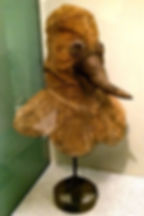Second Face! Masks and Judgement
- Siusan Patterson
- Apr 30, 2021
- 3 min read
Updated: Feb 1, 2023
Masks have become a real bone of contention during recent times, with opinions divided including:

'I don't mind them' ;
'we must';
'I love them';
'I have a dozen in different colours, they match my outfits!';
'I can't';
'I will if I have to!';
'only if I can wear it round my neck!'.
No matter what your opinion, in respect of the pandemic, masks are being encouraged as something that protects, either ourselves or others. Personally, they are something I've got used to and now it’s like second nature wearing one. I have even bought some that I feel I can make a statement with. My favourite is my black tartan one that I wear when I want to say 'back off- I'm not in the mood'! I wear this one a lot ha!
Interestingly though, masks for medical purposes can be traced back to the 17th century when beaked masks were worn during the plague epidemic. At the time, disease was believed to spread through miasmas — bad smells that wafted through the air. These masks had lenses on the eyes and a long beak like cavity in the nose, which was filled with drugs and aromatic herbs, spices and dried flowers. This cavity measured about 20cm in length and had 2 small vent holes. Creepy eh?! As if having the Plague wasn't terrifying enough all by itself, the "doctor" looked like something out of your ornithobic nightmares! ( is ornithobic even a word ha?)

Of course masks are not just for protection. They can also be used to disguise, hide, amuse or even frighten others. They can also be used to make a statement as is the case in the Black Lives Matter movement with some masks expressing ‘I can’t breathe’ – very powerful and moving images.
Metaphorically speaking, they can be something we wear to present ourselves to the world but used to hide what we really think or feel. A few years ago I was fortunate enough to visit a Cindy Sherman exhibition in Berlin. This included her collection of work ‘Stills’ where she uses prosthetics not only as a means of disguise but also as an act of performativity. Up close her work is both fascinating and unsettling in equal measure. Not only is Sherman’s own identity obscured, but each of the characters she portrays also reflect stereotypes, ‘stills’ within a larger, unknown narrative. To me, they reflect the struggle of women against collective cultural stereotypes. Sherman says: “I’m trying to make other people recognise something of themselves rather than me.”


During this pandemic, I have found it interesting how wearing a mask can conceal emotions and also can conceal a person’s age, gender, voice, and expressions, making them difficult to ‘read’. This resonates with me as I had been looking at masks in my own work just a couple of years ago pre Covid. I was interested in a type of mask called a Morretta mask ( also known as a muta mask) that was popular in 18th Century Venice and worn by women in social gatherings. The mask which was black, was placed over the face and had a button behind where the mouth is, and held in place by the wearer biting the button to hold the mask in place. This rendered the wearer speechless ( or mute hence the term Muta), concealed their identity and age and was successful at preventing judgements based on the individual's age, looks or how she sounded. It also provided the woman with an excuse when she did not want to talk to some of her would be suitors!
Venetian painter Pietro Longhi often showed masked figures in his work, including women in Morettas. His painting The Ridotto of Venice, depicts a gambling house and place for social gatherings. In the painting you can see the men scrutinising the women by their body shape and the state of their attire.

This is still true in today’s society where women of all ages are often judged on how they look or dress and are often made to feel less than. I wanted to challenge this particularly male perspective and I created a series of screen prints of women in Muta masks. Each one was an Artist Proof as I wanted to experiment with different colours of hair and body colours, contrasted against the mask, which I created with puffer ink to add texture. I was really pleased with them an in fact there are now only two remaining in my collection. I continue to reflect these themes in my work and reject these judgements, and to foster a more diverse and inclusive society.

Sign up to keep up to date with future blogs here
